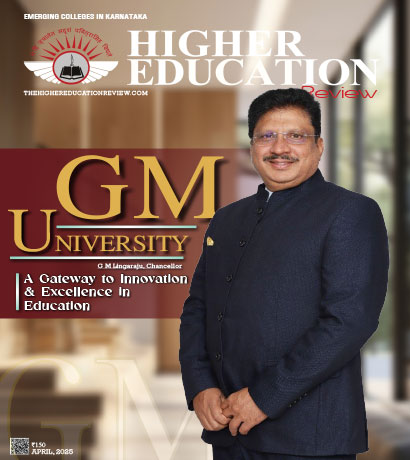Transforming the Classroom with Edtech

Ruchir Arora, Co-Founder and CEO, CollegeDekho.com
Digital whiteboards, tablets, laptops, projectors, video conferencing technologies - the evolved classroom has turned into an exciting place. Learning has become fun, and more importantly organic for today's digital natives. The classroom has become an extension of the students' normal lives where they are immersed in technology. Old school thinking may argue that all this is a distraction to learning. Far from being a distraction, technology is the enabler that all classroom need today.
The good news is that teachers are onboard with this new style of teaching. As per an industry survey, 86% of teachers think it is absolutely essential to use EdTech in the classroom, whereas 92% of teachers would like to use Ed-Tech even more. According to Forbes, EdTech will become a US$252 billion industry by 2020, with North America and Asia leading the pack.
Benefits Of Technology In The Classroom
Technology is helping shape students to not only academically excel but also become well-rounded individuals and citizens of the global world. Let's look at some of the key benefits of making technology an integral part of our learning methodology.
"Technology is helping shape students to not only academically excel but also become well-rounded individuals and citizens of the global world"
Improves understanding and information retention: When students learn with the help of familiar devices, it gives a new dimension to their learning and helps them grasp concepts better. For example, using virtual reality to take them inside a factory or on a field trip shows them how things work rather than mugging up what is written in a textbook. Similarly, learning math with gamification has higher stickiness with students and helps them retain that knowledge longer.
Enhances Learning Experience: Learning is no longer drab or something students are forced to do. Technology can equip students with e-books, podcasts, videos, tutorials and more. New-age learning software also provides alternative methods to tackle challenging subjects.
Facilitates Collaboration: Collaboration technologies enable multi-level synchronization of devices so students and teachers can come together for a cohesive study session within the classroom and beyond. They facilitate group projects where students can share study materials on forums with peers in the same school or other parts of the globe.
Personalizes learning: Technology also places immense power in the hands of the teachers to help them create more personalized, self-directed experiences for their students. By understanding individual needs, teachers can create their own digital content such as e-books, interactive modules, etc. that can help every student thrive.
Increases Student Engagement: Not all students are the same. While some naturally find it easier to participate in the classroom, it is challenging for others. Technology helps bridge this gap.
Teaches Skills Useful In The Real World: Skills such as using an Excel sheet, preparing a PowerPoint presentation, making videos, editing, etc. can be learnt in the classroom, unlike the previous generation that struggled in the workplace. Soft skills such as communication, leadership, critical thinking, teamwork, and more, are also honed with use of technology in everyday learning.
Prepares For The Future: Technology is all pervasive in the workplace today whether taking the startup route or the corporate one. Being comfortable with technology makes the transition into work-life easier. Irrespective of the career students choose, it prepares them to tackle challenges of the future.
Shattering Boundaries
Educational technologies are breaking geographical boundaries and making distance learning a new normal. More, universities today are providing online distance learning courses/ MOOCs to tap students across the globe. Online courses provide the flexibility and access these individuals need.
Technology is helping build virtual classrooms on a global stage. Audio conferencing, video conferencing, webinars and other collaborative softwares ensure seamless transfer of information, as well as two-way interactive communication, simulating a real-life classroom.
Imagine a scenario where a student in a small town of Zuluk in Sikkim, India is attending a post graduate course at the prestigious Princeton University. All he needs is a robust internet connection and a video conferencing software recommended by the university. He logs in at the correct time and attends the virtual class. A Q&A session later helps clarify his queries. He can submit his papers on a collaboration platform, as well as sit for a test or written exam. EdTech has truly opened doors of education to students across the globe.
Evening The Playground
Education technologies are proving to be game-changers in increasing literacy rate of nations such as India. Technology is helping bring education to underprivileged students whether it is basic or higher education. Technology is bringing access to smaller villages and towns and playing a key role in education inclusion.
Where faculty and infrastructure is a challenge, podcasts, mini video lessons, basic learning solutions are helping educate children. In fact, there are many burgeoning EdTech startups that are working towards solving the problem of illiteracy.
In Closing
We have only just started to scratch the surface of what technology can do to revolutionize learning. It is slowly and steadily overhauling teaching processes stuck in time. The schools of tomorrow will have to adapt and change in real-time to stay relevant and provide a competitive edge to their students. Technology is not just an enabler, it is the driving force for a transformative India.
Ruchir Arora, Co-Founder and CEO
Ruchir did his Mechanical Engineering from Visvesvaraya National Institute of Technology in 2001 and went to Indian School of Business for PGP in Information Technology and Finance. After his B.Tech, he worked for CSC for one year and then went for his PGP. After that, he worked with TechMahindra as a Manager. He also led Sales Operations for Shine.com, India's premier job portal, managing 200+ sales executives across 10 locations.
Ruchir founded HTCampus.com in 2010 targeting the education advertising and admissions services market. Education advertising, with an estimated market size of Rs 2500 cr is one of the largest classifieds markets in India.
The good news is that teachers are onboard with this new style of teaching. As per an industry survey, 86% of teachers think it is absolutely essential to use EdTech in the classroom, whereas 92% of teachers would like to use Ed-Tech even more. According to Forbes, EdTech will become a US$252 billion industry by 2020, with North America and Asia leading the pack.
Benefits Of Technology In The Classroom
Technology is helping shape students to not only academically excel but also become well-rounded individuals and citizens of the global world. Let's look at some of the key benefits of making technology an integral part of our learning methodology.
"Technology is helping shape students to not only academically excel but also become well-rounded individuals and citizens of the global world"
Improves understanding and information retention: When students learn with the help of familiar devices, it gives a new dimension to their learning and helps them grasp concepts better. For example, using virtual reality to take them inside a factory or on a field trip shows them how things work rather than mugging up what is written in a textbook. Similarly, learning math with gamification has higher stickiness with students and helps them retain that knowledge longer.
Enhances Learning Experience: Learning is no longer drab or something students are forced to do. Technology can equip students with e-books, podcasts, videos, tutorials and more. New-age learning software also provides alternative methods to tackle challenging subjects.
Facilitates Collaboration: Collaboration technologies enable multi-level synchronization of devices so students and teachers can come together for a cohesive study session within the classroom and beyond. They facilitate group projects where students can share study materials on forums with peers in the same school or other parts of the globe.
Personalizes learning: Technology also places immense power in the hands of the teachers to help them create more personalized, self-directed experiences for their students. By understanding individual needs, teachers can create their own digital content such as e-books, interactive modules, etc. that can help every student thrive.
Increases Student Engagement: Not all students are the same. While some naturally find it easier to participate in the classroom, it is challenging for others. Technology helps bridge this gap.
Teaches Skills Useful In The Real World: Skills such as using an Excel sheet, preparing a PowerPoint presentation, making videos, editing, etc. can be learnt in the classroom, unlike the previous generation that struggled in the workplace. Soft skills such as communication, leadership, critical thinking, teamwork, and more, are also honed with use of technology in everyday learning.
Prepares For The Future: Technology is all pervasive in the workplace today whether taking the startup route or the corporate one. Being comfortable with technology makes the transition into work-life easier. Irrespective of the career students choose, it prepares them to tackle challenges of the future.
Shattering Boundaries
Educational technologies are breaking geographical boundaries and making distance learning a new normal. More, universities today are providing online distance learning courses/ MOOCs to tap students across the globe. Online courses provide the flexibility and access these individuals need.
Technology is helping build virtual classrooms on a global stage. Audio conferencing, video conferencing, webinars and other collaborative softwares ensure seamless transfer of information, as well as two-way interactive communication, simulating a real-life classroom.
Imagine a scenario where a student in a small town of Zuluk in Sikkim, India is attending a post graduate course at the prestigious Princeton University. All he needs is a robust internet connection and a video conferencing software recommended by the university. He logs in at the correct time and attends the virtual class. A Q&A session later helps clarify his queries. He can submit his papers on a collaboration platform, as well as sit for a test or written exam. EdTech has truly opened doors of education to students across the globe.
Evening The Playground
Education technologies are proving to be game-changers in increasing literacy rate of nations such as India. Technology is helping bring education to underprivileged students whether it is basic or higher education. Technology is bringing access to smaller villages and towns and playing a key role in education inclusion.
Where faculty and infrastructure is a challenge, podcasts, mini video lessons, basic learning solutions are helping educate children. In fact, there are many burgeoning EdTech startups that are working towards solving the problem of illiteracy.
In Closing
We have only just started to scratch the surface of what technology can do to revolutionize learning. It is slowly and steadily overhauling teaching processes stuck in time. The schools of tomorrow will have to adapt and change in real-time to stay relevant and provide a competitive edge to their students. Technology is not just an enabler, it is the driving force for a transformative India.
Ruchir Arora, Co-Founder and CEO
Ruchir did his Mechanical Engineering from Visvesvaraya National Institute of Technology in 2001 and went to Indian School of Business for PGP in Information Technology and Finance. After his B.Tech, he worked for CSC for one year and then went for his PGP. After that, he worked with TechMahindra as a Manager. He also led Sales Operations for Shine.com, India's premier job portal, managing 200+ sales executives across 10 locations.
Ruchir founded HTCampus.com in 2010 targeting the education advertising and admissions services market. Education advertising, with an estimated market size of Rs 2500 cr is one of the largest classifieds markets in India.

